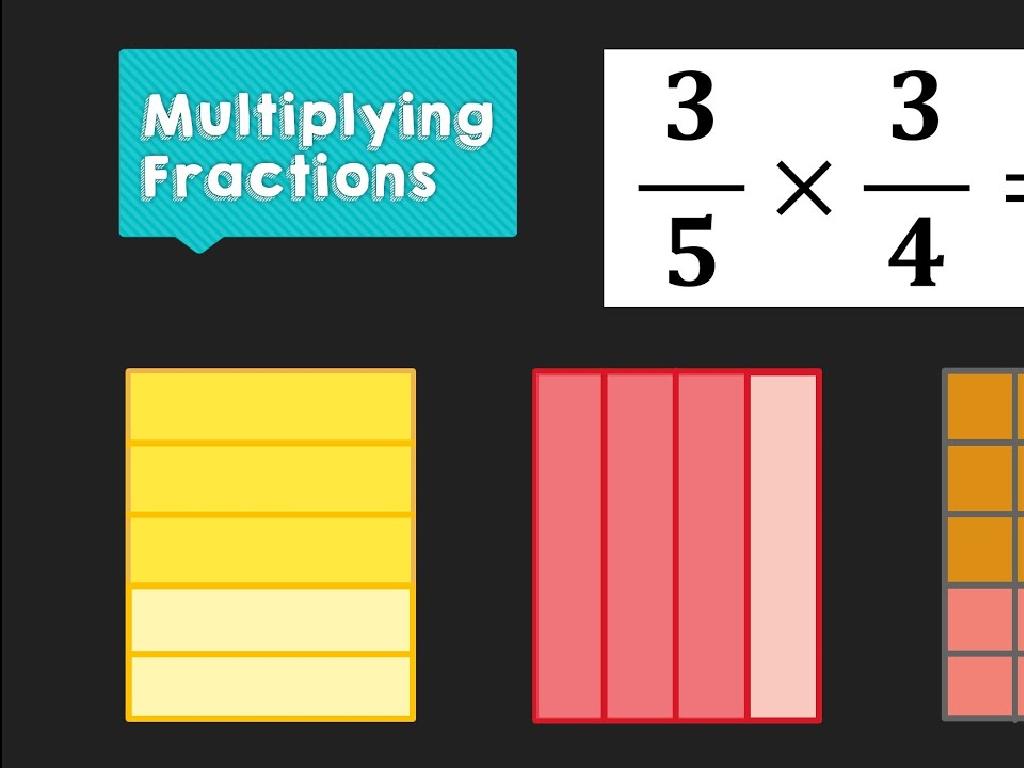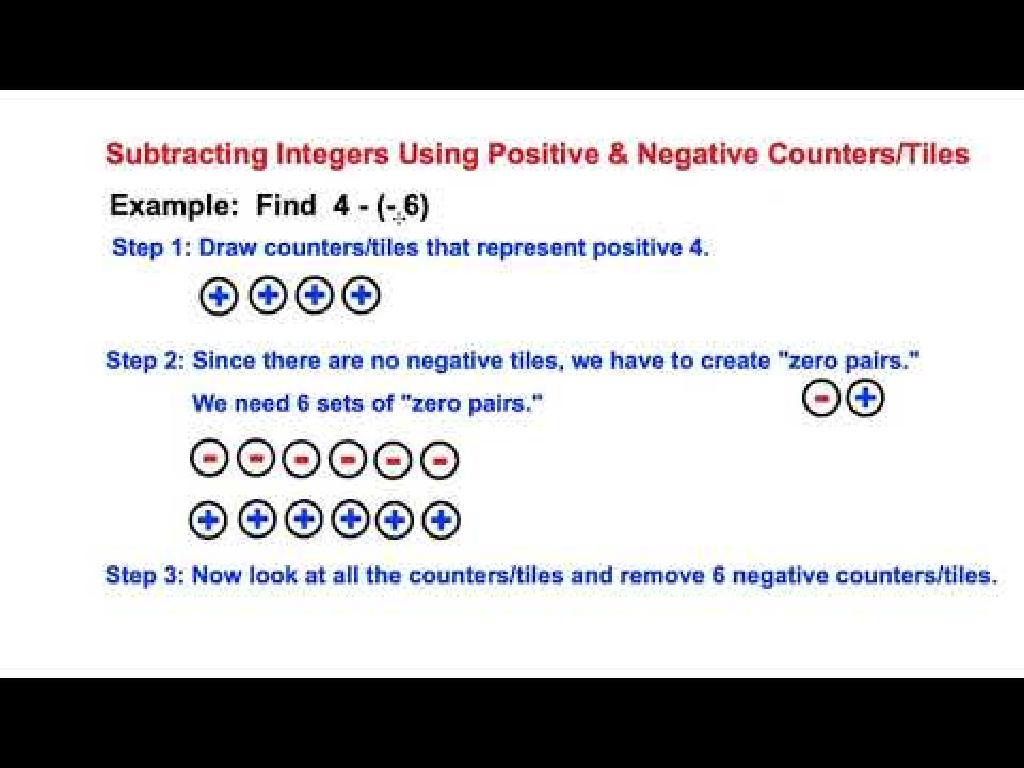Subtract Zero Or All
Subject: Math
Grade: Second grade
Topic: Subtraction Strategies: One Digit
Please LOG IN to download the presentation. Access is available to registered users only.
View More Content
Subtraction Strategies: Zero or All
– Learn to subtract zero from a number
– Subtracting zero keeps the number same
– Understand subtracting all from a number
– When you subtract all, the answer is zero
– Discover why these subtractions are special
– These are key rules in subtraction
– Practice with examples
– Let’s try 5 – 0 and 5 – 5 together
|
This slide introduces the concept of subtracting zero or all from a number, which are fundamental concepts in subtraction. When we subtract zero from any number, the number remains unchanged. This is an important property for students to recognize as it helps build their understanding of the identity element in subtraction. Conversely, when we subtract the whole amount (all) from itself, the result is zero. These concepts will be reinforced through practice and examples. Encourage the students to think of subtraction as ‘taking away’ and use real-life scenarios such as having five apples and not taking any away (subtracting zero) or taking all five apples away (subtracting all) to illustrate the point.
Understanding Subtraction: Subtract Zero or All
– Subtraction means taking away
– It shows how many are left
– Subtracting zero keeps number same
– If you have 5 apples and subtract 0, you still have 5 apples.
– Subtracting all leaves nothing
– If you have 5 apples and subtract 5, you have 0 apples left.
|
This slide introduces the basic concept of subtraction to second graders. Subtraction is explained as the process of taking away one number from another, which helps us figure out the remaining quantity. Emphasize that when we subtract zero from a number, the number stays the same because nothing is taken away. Conversely, when we subtract the entire amount (all), there is nothing left. Use relatable examples like apples to illustrate these points. Encourage students to think of subtraction as a useful tool in everyday life, such as when they eat some of their snacks and want to know how many are left.
Subtracting Zero: Keeping Numbers the Same
– Subtracting zero keeps number same
– No matter what number, taking away zero means it doesn’t change.
– Example with apples
– If you start with 5 apples and subtract 0, you still have all your 5 apples!
|
This slide introduces the concept of subtracting zero from a number. It’s important to emphasize to the students that when we subtract zero, the number does not change at all; it stays exactly the same. Use tangible examples like apples to illustrate this point, as it helps the students to visualize and understand the concept better. Ask the students if they have ever had a situation where they thought they would lose something but ended up with the same amount. Relate this to subtracting zero. You can also use other examples with different objects to reinforce the concept.
Subtraction Strategy: Subtracting All
– Subtracting all equals zero
– When you take away all, nothing is left.
– Example with apples
– 5 apples – 5 apples = 0 apples
|
This slide introduces the concept of ‘subtracting all’ as a subtraction strategy. Emphasize to the students that when they subtract the entire amount of something, they are left with zero. Use tangible examples like apples to illustrate this point, as it’s relatable and easy to visualize. Ask the students if they have ever had a certain number of items and then took all of those items away, what were they left with? This will help them connect the concept to real-life experiences. Encourage them to think of other examples where they might subtract all of something. This foundational understanding will be crucial for more complex subtraction problems in the future.
Let’s Practice Together: Subtracting Zero or All
– Subtracting zero from a number
– Subtracting a number from itself
– Interactive solving: 6 – 0 = ?
– What’s left when we take zero away from six?
– Interactive solving: 4 – 4 = ?
– What do we get when we take four from four?
|
This slide is designed to be an interactive practice for students to understand the concepts of subtracting zero from a number and subtracting a number from itself. The first example illustrates that when you subtract zero from any number, the number stays the same. The second example shows that when a number is subtracted from itself, the result is zero. Encourage the students to solve these problems aloud with you, reinforcing the concept that subtracting zero does not change the value and subtracting all leaves nothing. Use manipulatives or visual aids if necessary to help students grasp the concept. After explaining, ask the students to try similar problems on their own to ensure understanding.
Subtraction is Fun!
– Subtracting zero keeps the number
5 – 0 = 5. The number doesn’t change!
– Taking away all equals zero
5 – 5 = 0. All gone, nothing left!
– Practice with examples
– Understand through activities
|
This slide introduces the basic concepts of subtraction to second graders, emphasizing the rules when subtracting zero or all of a number. The first point should clarify that subtracting zero from any number will leave the original number unchanged, which is a fundamental property in mathematics. The second point illustrates that if you take away all of a number, you’re left with zero. Provide simple examples like 5 – 0 = 5 and 5 – 5 = 0 to solidify understanding. Encourage students to practice with different numbers and use objects like counters or blocks for a hands-on activity to reinforce the concept. The goal is for students to internalize these subtraction properties through repetition and engaging activities.
Class Activity: Subtraction Bingo
– Play Bingo with subtraction problems
– Solve problems and mark your card
– Aim for a full row to win
– Have fun learning subtraction!
|
This interactive class activity is designed to make learning subtraction fun through a game of Bingo. Each student will receive a Bingo card with a variety of answers from subtraction problems. As you call out different subtraction problems, students will solve them and mark off the answers on their cards. The goal is to get a full row marked off, whether it’s horizontal, vertical, or diagonal. The first student to achieve this wins the game. This activity not only reinforces the concept of subtraction but also encourages quick mental math skills. Possible variations of the activity could include using different subtraction strategies, having students create their own Bingo cards with their choice of answers, or playing until multiple students have Bingo to maximize participation.






